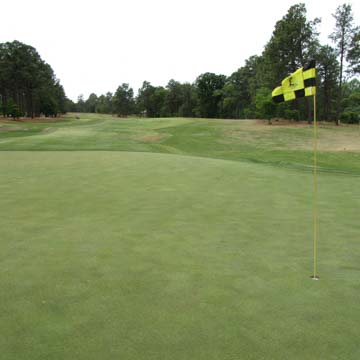You are here
Pinehurst Golf Course
The Pinehurst Resort was conceived in 1895 by soda fountain magnate James Walker Tufts. Approximately 6,000 acres of scrub-pine landscape was purchased in the sand-hills region of Moore County to capitalize on the supposed curative effects of the dry climate and clean waters. A plan for the grounds was drawn up by the firm of Olmsted, Olmsted and Eliot, and carried out by landscape architect Warren Manning. Recreational amenities soon became a focus of the Pinehurst Resort. Although the game of golf was only just gaining traction in America, and Tufts initially dismissed it as a fad, his son, Leonard, convinced him to incorporate a rudimentary course (laid out by Dr. Leroy Culver) onto the property in 1898.
The arrival of Scottish golf professional and greenkeeper Donald J. Ross in 1900, however, helped transform Pinehurst into a golf destination that ultimately earned the moniker, “The Cradle of American Golf.” Today, nine courses accommodate all ranges of skill levels at this high-end but publically accessible resort. It is the second course—simply referred to as “No. 2”—that rightly receives the most acclaim, having played host to more prestigious golf competitions over the past century than any other course in America.
First opened for play in 1907, the routing of the various holes on No. 2 supplanted an existing 9-hole short course that Ross himself had designed in 1901–1902. The new course, measuring just under 5,900 yards and spread out over nearly 200 acres, incorporated wide playing corridors that fit the natural lay of the land. Lacking much in the way of bold, natural topography to create interest, Ross’s generally subdued design shines in its ability to provide strategically relevant playing angles for golfers of all levels and playing ability. A significant change occurred in 1935 when the existing greens, which were composed of compacted sand held together by oil (a common practice in the southern U.S. prior to an array of agronomic advances), were replaced by turfgrass. Ross used this opportunity to re-contour the greens into their now iconic domed surfaces, often raised well above the neighboring grade. There is some controversy, however, as to whether Ross designed these greens or whether they have evolved over the years into their current form due to unintended consequences of a regular maintenance process called top-dressing. Either way, these greens average almost 6,500 square feet each and serve to repel misplayed or indifferent shots, adding immeasurably to the strategic nature of the playing field and further underscoring the Pinehurst No. 2 golf course as a unique venue.
After Ross’s death in 1948, evolving trends in design and maintenance practices led to a markedly different presentation of the golf course that featured narrowed fairways surrounded by thick bermudagrass rough. In 2010, Bill Coore and Ben Crenshaw sympathetically restored the course to Ross’s original playing strategies and visual aesthetic in time for Pinehurst to host the U.S. Open and U.S. Women’s Open championships in 2014. The scope of the work included the recapturing of fairway widths, the restoration of the course’s 111 sand bunkers, and the elimination of all bermudagrass roughs in favor of re-establishing areas of sandy scrub and native wire grass that mimicked the original landscape condition. Though referred to as a restoration, the course has nevertheless been stretched to nearly 7,600 yards at its extent to keep pace with the technological innovations in modern balls and clubs. Additionally, over 1,000 irrigation heads were removed from the ground in this project, resulting in a decreased water budget and improved playing conditions.
References
Klein, Bradley. Discovering Donald Ross: The Architect and His Golf Courses. Chelsea, MI: Sleeping Bear Press, 2001.
Moss, Richard J. “Constructing Eden: The Early Days of Pinehurst, North Carolina.” New England Quarterly72, no. 3 (September 1999): 388-414.
Starn, Orin. “Caddying for the Dalai Lama: Golf, Heritage Tourism, and the Pinehurst Resort.” South Atlantic Quarterly105, no. 2 (Spring 2006): 447-463.
Hood, Davyd Foard, and Laura A. W. Phillips, “Pinehurst Historic District,” National Historic Landmark Nomination Form, 1998. National Park Service, U.S. Department of the Interior, Washington, D.C.
Writing Credits
If SAH Archipedia has been useful to you, please consider supporting it.
SAH Archipedia tells the story of the United States through its buildings, landscapes, and cities. This freely available resource empowers the public with authoritative knowledge that deepens their understanding and appreciation of the built environment. But the Society of Architectural Historians, which created SAH Archipedia with University of Virginia Press, needs your support to maintain the high-caliber research, writing, photography, cartography, editing, design, and programming that make SAH Archipedia a trusted online resource available to all who value the history of place, heritage tourism, and learning.

